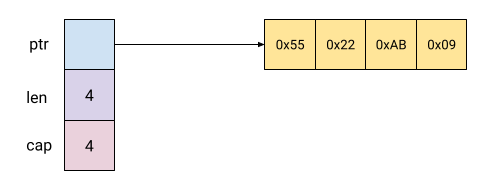為什么 Go 不支持 []T 轉換為 []interface
在 Go 中,如果 interface{} 作為函數參數的話,是可以傳任意參數的,然后通過類型斷言來轉換。
舉個例子:
package main
import "fmt"
func foo(v interface{}) {
if v1, ok1 := v.(string); ok1 {
fmt.Println(v1)
} else if v2, ok2 := v.(int); ok2 {
fmt.Println(v2)
}
}
func main() {
foo(233)
foo("666")
}
不管是傳 int 還是 string,最終都能輸出正確結果。
那么,既然是這樣的話,我就有一個疑問了,拿出我舉一反三的能力。是否可以將 []T 轉換為 []interface 呢?
比如下面這段代碼:
func foo([]interface{}) { /* do something */ }
func main() {
var a []string = []string{"hello", "world"}
foo(a)
}
很遺憾,這段代碼是不能編譯通過的,如果想直接通過 b := []interface{}(a) 的方式來轉換,還是會報錯:
cannot use a (type []string) as type []interface {} in function argument
正確的轉換方式需要這樣寫:
b := make([]interface{}, len(a), len(a))
for i := range a {
b[i] = a[i]
}
本來一行代碼就能搞定的事情,卻非要讓人寫四行,是不是感覺很麻煩?那為什么 Go 不支持呢?我們接著往下看。
官方解釋
這個問題在官方 Wiki 中是有回答的,我復制出來放在下面:
The first is that a variable with type
[]interface{}is not an interface! It is a slice whose element type happens to be interface{}. But even given this, one might say that the meaning is clear.
Well, is it? A variable with type[]interface{}has a specific memory layout, known at compile time.
Each interface{} takes up two words (one word for the type of what is contained, the other word for either the contained data or a pointer to it). As a consequence, a slice with length N and with type[]interface{}is backed by a chunk of data that is N*2 words long.
This is different than the chunk of data backing a slice with type[]MyTypeand the same length. Its chunk of data will beN*sizeof(MyType)words long.
The result is that you cannot quickly assign something of type[]MyTypeto something of type[]interface{}; the data behind them just look different.
大概意思就是說,主要有兩方面原因:
[]interface{}類型并不是interface,它是一個切片,只不過碰巧它的元素是interface;[]interface{}是有特殊內存布局的,跟interface不一樣。
下面就來詳細說說,是怎么個不一樣。
內存布局
首先來看看 slice 在內存中是如何存儲的。在源碼中,它是這樣定義的:
// src/runtime/slice.go
type slice struct {
array unsafe.Pointer
len int
cap int
}
array是指向底層數組的指針;len是切片的長度;cap是切片的容量,也就是array數組的大小。
舉個例子,創建如下一個切片:
is := []int64{0x55, 0x22, 0xab, 0x9}
那么它的布局如下圖所示:

假設程序運行在 64 位的機器上,那么每個「正方形」所占空間是 8 bytes。上圖中的 ptr 所指向的底層數組占用空間就是 4 個「正方形」,也就是 32 bytes。
接下來再看看 []interface{} 在內存中是什么樣的。
回答這個問題之前先看一下 interface{} 的結構,Go 中的接口類型分成兩類:
iface表示包含方法的接口;eface表示不包含方法的空接口。
源碼中的定義分別如下:
type iface struct {
tab *itab
data unsafe.Pointer
}
type eface struct {
_type *_type
data unsafe.Pointer
}
具體細節我們不去深究,但可以明確的是,每個 interface{} 包含兩個指針, 會占據兩個「正方形」。第一個指針指向 itab 或者 _type;第二個指針指向實際的數據。
所以它在內存中的布局如下圖所示:

因此,不能直接將 []int64 直接傳給 []interface{}。
程序運行中的內存布局
接下來換一個更形象的方式,從程序實際運行過程中,看看內存的分布是怎么樣的?
看下面這樣一段代碼:
package main
var sum int64
func addUpDirect(s []int64) {
for i := 0; i < len(s); i++ {
sum += s[i]
}
}
func addUpViaInterface(s []interface{}) {
for i := 0; i < len(s); i++ {
sum += s[i].(int64)
}
}
func main() {
is := []int64{0x55, 0x22, 0xab, 0x9}
addUpDirect(is)
iis := make([]interface{}, len(is))
for i := 0; i < len(is); i++ {
iis[i] = is[i]
}
addUpViaInterface(iis)
}
我們使用 Delve 來進行調試,可以點擊這里進行安裝。
dlv debug slice-layout.go
Type 'help' for list of commands.
(dlv) break slice-layout.go:27
Breakpoint 1 set at 0x105a3fe for main.main() ./slice-layout.go:27
(dlv) c
> main.main() ./slice-layout.go:27 (hits goroutine(1):1 total:1) (PC: 0x105a3fe)
22: iis := make([]interface{}, len(is))
23: for i := 0; i < len(is); i++ {
24: iis[i] = is[i]
25: }
26:
=> 27: addUpViaInterface(iis)
28: }
打印 is 的地址:
(dlv) p &is
(*[]int64)(0xc00003a740)
接下來看看 slice 在內存中都包含了哪些內容:
(dlv) x -fmt hex -len 32 0xc00003a740
0xc00003a740: 0x10 0xa7 0x03 0x00 0xc0 0x00 0x00 0x00
0xc00003a748: 0x04 0x00 0x00 0x00 0x00 0x00 0x00 0x00
0xc00003a750: 0x04 0x00 0x00 0x00 0x00 0x00 0x00 0x00
0xc00003a758: 0x00 0x00 0x09 0x00 0xc0 0x00 0x00 0x00
每行有 8 個字節,也就是上文說的一個「正方形」。第一行是指向數據的地址;第二行是 4,表示切片長度;第三行也是 4,表示切片容量。
再來看看指向的數據到底是怎么存的:
(dlv) x -fmt hex -len 32 0xc00003a710
0xc00003a710: 0x55 0x00 0x00 0x00 0x00 0x00 0x00 0x00
0xc00003a718: 0x22 0x00 0x00 0x00 0x00 0x00 0x00 0x00
0xc00003a720: 0xab 0x00 0x00 0x00 0x00 0x00 0x00 0x00
0xc00003a728: 0x09 0x00 0x00 0x00 0x00 0x00 0x00 0x00
這就是一片連續的存儲空間,保存著實際數據。
接下來用同樣的方式,再來看看 iis 的內存布局。
(dlv) p &iis
(*[]interface {})(0xc00003a758)
(dlv) x -fmt hex -len 32 0xc00003a758
0xc00003a758: 0x00 0x00 0x09 0x00 0xc0 0x00 0x00 0x00
0xc00003a760: 0x04 0x00 0x00 0x00 0x00 0x00 0x00 0x00
0xc00003a768: 0x04 0x00 0x00 0x00 0x00 0x00 0x00 0x00
0xc00003a770: 0xd0 0xa7 0x03 0x00 0xc0 0x00 0x00 0x00
切片的布局和 is 是一樣的,主要的不同是所指向的數據:
(dlv) x -fmt hex -len 64 0xc000090000
0xc000090000: 0x00 0xe4 0x05 0x01 0x00 0x00 0x00 0x00
0xc000090008: 0xa8 0xee 0x0a 0x01 0x00 0x00 0x00 0x00
0xc000090010: 0x00 0xe4 0x05 0x01 0x00 0x00 0x00 0x00
0xc000090018: 0x10 0xed 0x0a 0x01 0x00 0x00 0x00 0x00
0xc000090020: 0x00 0xe4 0x05 0x01 0x00 0x00 0x00 0x00
0xc000090028: 0x58 0xf1 0x0a 0x01 0x00 0x00 0x00 0x00
0xc000090030: 0x00 0xe4 0x05 0x01 0x00 0x00 0x00 0x00
0xc000090038: 0x48 0xec 0x0a 0x01 0x00 0x00 0x00 0x00
仔細觀察上面的數據,偶數行內容都是相同的,這個是 interface{} 的 itab 地址。奇數行內容是不同的,指向實際的數據。
打印地址內容:
(dlv) x -fmt hex -len 8 0x010aeea8
0x10aeea8: 0x55 0x00 0x00 0x00 0x00 0x00 0x00 0x00
(dlv) x -fmt hex -len 8 0x010aed10
0x10aed10: 0x22 0x00 0x00 0x00 0x00 0x00 0x00 0x00
(dlv) x -fmt hex -len 8 0x010af158
0x10af158: 0xab 0x00 0x00 0x00 0x00 0x00 0x00 0x00
(dlv) x -fmt hex -len 8 0x010aec48
0x10aec48: 0x09 0x00 0x00 0x00 0x00 0x00 0x00 0x00
很明顯,通過打印程序運行中的狀態,和我們的理論分析是一致的。
通用方法
通過以上分析,我們知道了不能轉換的原因,那有沒有一個通用方法呢?因為我實在是不想每次多寫那幾行代碼。
也是有的,用反射 reflect,但是缺點也很明顯,效率會差一些,不建議使用。
func InterfaceSlice(slice interface{}) []interface{} {
s := reflect.ValueOf(slice)
if s.Kind() != reflect.Slice {
panic("InterfaceSlice() given a non-slice type")
}
// Keep the distinction between nil and empty slice input
if s.IsNil() {
return nil
}
ret := make([]interface{}, s.Len())
for i := 0; i < s.Len(); i++ {
ret[i] = s.Index(i).Interface()
}
return ret
}
還有其他方式嗎?答案就是 Go 1.18 支持的泛型,這里就不過多介紹了,大家有興趣的話可以繼續研究。
以上就是本文的全部內容,如果覺得還不錯的話歡迎點贊,轉發和關注,感謝支持。
微信搜索「AlwaysBeta」,第一時間獲取文章更新。
參考文章:
- https://stackoverflow.com/questions/12753805/type-converting-slices-of-interfaces
- https://github.com/golang/go/wiki/InterfaceSlice
- https://eli.thegreenplace.net/2021/go-internals-invariance-and-memory-layout-of-slices/
推薦閱讀:



 浙公網安備 33010602011771號
浙公網安備 33010602011771號